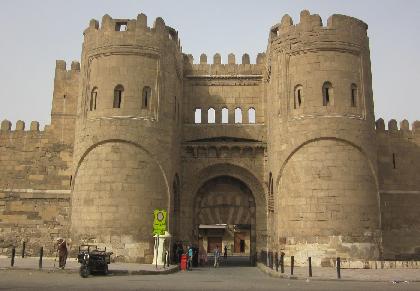
 Bab El Futuh or the gate of conquest, the northen fortress of Fatimid Cairo, lies in the Street of Bab El-Nasr next to the mosque of El-Hakim . This gate and the other gates including Bab El-Nasr were established by the Armenian Emir Badr El-Gamaly before the Crusaders as a replacement of the broken down walls of Gawhar in order to protect the Fatimid Cairo. This gate is considered as a rare example for the buildings that are designed on the military Islamic art and it is handsomely ornamented from its either sides. Inside the gate appear some handsomely ornamented stair-steps leading to the top of the wall from which one can enjoy an overall view of the Fatimid main street and the large number of stalls on its either sides.There is also a room that was dedicated to gathering the troops. Of special note in Bab El-Futuh are the parts that were salvaged from Memphis Pharaonic complex including the interweaving vaults, the windows that are beautified with hippopotamus and other reliefs. Some parts of the walls that extend in the area between Bab El-Futuh and Bab El-Nasr are removed now. It is worth time to look at the nice diamond carved motifs and the splayed arches that beautify these walls. There were protrusions supported with cornices over the gate through which the fighters were throwing their enemies with boiling oil. The major part of the remaining walls is in a good state. In the eastern end of the wall one find the projecting latrine that appears as a balcony imparting from the crenellations.
Bab El Futuh or the gate of conquest, the northen fortress of Fatimid Cairo, lies in the Street of Bab El-Nasr next to the mosque of El-Hakim . This gate and the other gates including Bab El-Nasr were established by the Armenian Emir Badr El-Gamaly before the Crusaders as a replacement of the broken down walls of Gawhar in order to protect the Fatimid Cairo. This gate is considered as a rare example for the buildings that are designed on the military Islamic art and it is handsomely ornamented from its either sides. Inside the gate appear some handsomely ornamented stair-steps leading to the top of the wall from which one can enjoy an overall view of the Fatimid main street and the large number of stalls on its either sides.There is also a room that was dedicated to gathering the troops. Of special note in Bab El-Futuh are the parts that were salvaged from Memphis Pharaonic complex including the interweaving vaults, the windows that are beautified with hippopotamus and other reliefs. Some parts of the walls that extend in the area between Bab El-Futuh and Bab El-Nasr are removed now. It is worth time to look at the nice diamond carved motifs and the splayed arches that beautify these walls. There were protrusions supported with cornices over the gate through which the fighters were throwing their enemies with boiling oil. The major part of the remaining walls is in a good state. In the eastern end of the wall one find the projecting latrine that appears as a balcony imparting from the crenellations.

Bab El-Azab
The Gate or Bab El-Azab that situates in El-Qalaa off Salah El-Deen Square was attached by Sultan Radwan Katkhuda to the Citadel. It was use